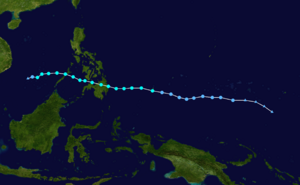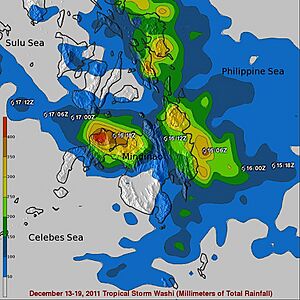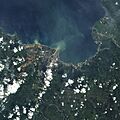Tropical Storm Washi facts for kids
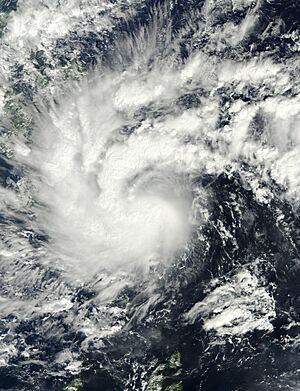
Severe Tropical Storm Washi approaching Mindanao on December 16
|
|
| Meteorological history | |
|---|---|
| Formed | December 13, 2011 |
| Dissipated | December 19, 2011 |
| Unknown strength tropical cyclone | |
| 10-minute sustained (JMA) | |
| Highest winds | 95 km/h (60 mph) |
| Lowest pressure | 992 hPa (mbar); 29.29 inHg |
| Tropical storm | |
| 1-minute sustained (SSHWS/JTWC) | |
| Highest winds | 95 km/h (60 mph) |
| Lowest pressure | 985 hPa (mbar); 29.09 inHg |
| Overall effects | |
| Fatalities | 1,268 – 1,472 |
| Missing | 181 – 1,074 |
| Damage | $97.8 million (2011 USD) |
| Areas affected | Caroline Islands, Philippines |
|
Part of the 2011 Pacific typhoon season |
|
Severe Tropical Storm Washi, also known in the Philippines as Severe Tropical Storm Sendong, was a powerful tropical storm that hit the Philippines in late 2011. It caused a lot of damage and led to the deaths of over 1,200 people. Washi first made landfall on Mindanao, a large island in the Philippines, on December 16. It then weakened a bit but got stronger again over the Sulu Sea. The storm made landfall a second time over Palawan on December 17.
Contents
How Tropical Storm Washi Formed
On December 12, 2011, weather experts noticed an area of low pressure forming. It was about 945 kilometers (585 miles) south-southeast of Guam. This system was moving west towards the Philippines. It was in a good spot for a storm to grow stronger.
Washi Becomes a Tropical Storm
As the system moved, it started to develop more. On December 13, both the Joint Typhoon Warning Center (JTWC) and the Japan Meteorological Agency (JMA) called it a tropical depression. This is the first stage of a tropical cyclone.
At first, strong winds high in the atmosphere pushed the thunderstorms away from the center of the depression. This stopped it from getting stronger quickly. But by December 14, the thunderstorms reformed, and the JTWC said it had become a tropical storm.
Washi Enters the Philippines and Gets a Local Name
On December 15, the storm moved into the area watched by the Philippine weather agency (PAGASA). PAGASA then started giving updates and named the storm Sendong. Soon after, the storm passed near or over Palau.
Later that day, the JMA also upgraded the system to a tropical storm and gave it the international name Washi. The storm kept moving quickly to the west and became more organized. On December 16, Washi reached its strongest point as a severe tropical storm. It then made its first landfall on the eastern coast of Mindanao.
Washi Weakens and Dissipates
After crossing Mindanao, Washi became weaker because it was over land. However, it quickly regained strength over the Sulu Sea. On December 17, Washi crossed Palawan and moved into the South China Sea.
The storm left the Philippine area on December 18. Washi then weakened into a tropical depression and finally disappeared on December 19. This happened because it met cool, dry air from the Northeast Monsoon.
How Tropical Storm Washi Affected the Philippines
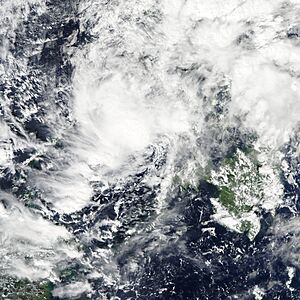
Tropical Storm Washi brought very heavy rain to the Cagayan de Oro river basin in Mindanao. The wind from Macajalar Bay pushed moist air up the nearby mountains, like Mount Makaturing and Mount Kitanglad. This caused even more rain to fall.
Heavy Rainfall and Flash Floods
One weather station recorded 475 millimeters (18.7 inches) of rain in just 24 hours. This amount of rain is usually only seen once every 20 years in that area. In Lumbia, 180.9 millimeters (7.12 inches) of rain fell in 24 hours. This was more than 60 percent of the rain they usually get in all of December.
Satellite images showed that some areas around the Cagayan de Oro river received over 400 millimeters (15.7 inches) of rain. In some places, the rain was so intense that 60.6 millimeters (2.39 inches) fell in just one hour.
The heavy rain caused flash floods in the Cagayan de Oro, Iponan, and Mandulog rivers. In some spots, the water rose by 3.3 meters (11 feet) in less than an hour. A high tide in Macajalar Bay made the flooding even worse, pushing water into areas that would normally be safe.
The rivers swelled to 7 to 9 meters (23 to 30 feet) high. This was considered a "75-year flood event" in some areas, meaning it was a very rare and severe flood. Many people in these areas felt safe from typhoons because they were not in the main "typhoon belt."
Impact on Cities and People
The floods hit around 2:30 a.m. local time, when most people were asleep. This meant many could not hear the warnings from PAGASA. The cities of Cagayan de Oro and Iligan were hit the hardest. Many lives were lost there. In Cagayan de Oro, some neighborhoods like Balulang, Carmen, and Macasandig were almost completely destroyed.
Between these two cities, 1,147 people died, and 1,993 were injured. People caught in the floods had to climb onto their roofs to escape the rising water, while winds blew at 90 km/h (55 mph). The mayor of Iligan said these were the worst floods in the city's history.
Overall, nearly 40,000 homes were damaged, and 11,463 were completely destroyed. Almost 700,000 people were affected by the storm. The total number of deaths is estimated to be between 1,268 and 2,546. The storm also caused about ₱2.068 billion (about $48.4 million USD) in damage. More than half of this damage was to roads and bridges.
Public Storm Warning Signals
The Philippine weather agency (PAGASA) issued storm warning signals to warn people about the storm.
| PSWS# | Luzon | Visayas | Mindanao |
|---|---|---|---|
| 2 | Palawan | Southern Leyte, Bohol, Southern portion of Cebu, Southern portion of Negros Oriental, Southern Portion of Negros Occidental, Siquijor | Surigao del Norte incl. Siargao Island, Surigao del Sur, Dinagat Province, Agusan del Norte, Agusan del Sur, Davao del Norte, Davao Oriental, Samal Island, Lanao del Norte, Lanao del Sur, Misamis Occidental, Misamis Oriental, Zamboanga del Norte, Zamboanga del Sur, North Cotabato, Compostela Valley, Camiguin, Bukidnon, Maguindanao, Camotes Islands |
| 1 | Masbate, Sorsogon, Ticao Islands, Cuyo Islands, Coron | Eastern Samar, Western portion of Samar, Northern portion of Leyte, Rest of Cebu, Rest of Negros Oriental, Rest of Negros Occidental, Capiz, Antique, Aklan, Iloilo, Guimaras | None |
Aftermath and Recovery Efforts
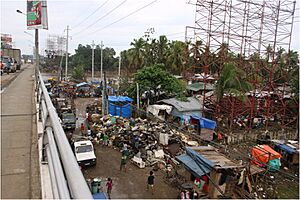
On the morning of December 17, 2011, a huge effort began to help people. About 100,000 people were moved to safer places. Around 20,000 soldiers were sent to help with rescue and cleanup. The Philippine Coast Guard searched for missing people, especially after reports that some villages had been swept into the sea.
President Benigno Aquino III visited Cagayan de Oro and Iligan on December 20, 2011. He declared a state of national calamity for the affected areas. He also asked citizens to help the victims, especially during the Christmas season.
In the years after Washi, the government set aside ₱2.57 billion (about US$58 million) to build new homes. These homes were designed to be strong enough to withstand winds of 220 km/h (137 mph). By December 2014, many of these shelters were built, especially in Cagayan de Oro and Iligan.
Help from Other Countries
Many countries and organizations sent help to the Philippines after Tropical Storm Sendong (Washi).
 Australia
Australia
- The Australian government gave A$1 million (about US$1.01 million) in money.
 Denmark
Denmark
- The Danish government provided 300,000 DKK (about US$53,000) for things like food, water, and blankets.
 European Union
European Union
- The European Commission gave €3 million (about $3.9 million) for emergency help.
 France
France
- The French Government provided €50,000 (about US$65,000) in emergency money.
 Indonesia
Indonesia
- The Indonesian government gave $50,000 and offered to send rescue and medical teams.
 Japan
Japan
- The Japanese government provided 25 million yen (about US$320,000) worth of relief goods, like water tanks and generators.
 Malaysia
Malaysia
- The Malaysian government gave $100,000 to help with relief and rebuilding.
 People's Republic of China
People's Republic of China
- The Chinese government provided $1.1 million in money.
 Singapore
Singapore
- The Singapore government gave S$50,000 (about US$39,000) in funds and S$27,800 (about US$22,000) worth of relief goods.
 South Korea
South Korea
- The South Korean government provided $500,000 in money.
 Switzerland
Switzerland
- Six members of the Swiss Humanitarian Aid Unit went to Mindanao to help ensure clean drinking water.
 United Kingdom
United Kingdom
- The British Red Cross gave £140,000 (about US$220,000) to support relief efforts.
 United Nations
United Nations
- The United Nations Emergency Relief Agency released $3 million to improve water and sanitation.
- The United Nations Department of Humanitarian Affairs planned to raise $26.8 million for victims.
- UN Secretary-General Ban Ki-moon said the UN would help as needed.
- The United Nations Children's Fund asked for $4.2 million for the Philippines.
 United States
United States
- The United States provided $100,000 to help.
- The US ambassador, Harry K. Thomas Jr., expressed sympathy.
- The United States Agency for International Development sent hygiene kits, water purification tablets, and containers.
Names Retired After the Storm
Because of the many deaths it caused, PAGASA announced that the name Sendong would no longer be used for tropical cyclones in the Philippines. In June 2012, they chose the name Sarah to replace it for future storm seasons.
In February 2012, the ESCAP/WMO Typhoon Committee also decided to retire the international name Washi. It was replaced with the name Hato. However, Hato was also retired later in 2017 and replaced with Yamaneko.
See also
- 2011 Southeast Asian floods
- Other Philippine tropical cyclones that have claimed more than 1,000 lives
- Typhoon Bopha (Pablo, 2012)
- Typhoon Fengshen (Frank, 2008)
- Typhoon Durian (Reming, 2006)
- Tropical Depression Winnie, 2004
- Tropical Storm Thelma (Uring, 1991)
- Typhoon Haiyan (Yolanda, 2013), deadliest tropical cyclone to strike the Philippines in recent recorded history
- Other significant Philippine tropical cyclones
- Typhoon Angela (Rosing, 1995)
- Typhoon Ketsana (Ondoy, 2009)
- Typhoon Tembin (Vinta, 2017) – made landfall in a similar area 6 years later
- Typhoon Rai (Odette, 2021) – a powerful tropical cyclone that affected similar areas exactly 10 years later
- Tropical Storm Nalgae (Paeng, 2022) – a deadly and very large tropical storm that also caused flash flooding in Mindanao
Images for kids


